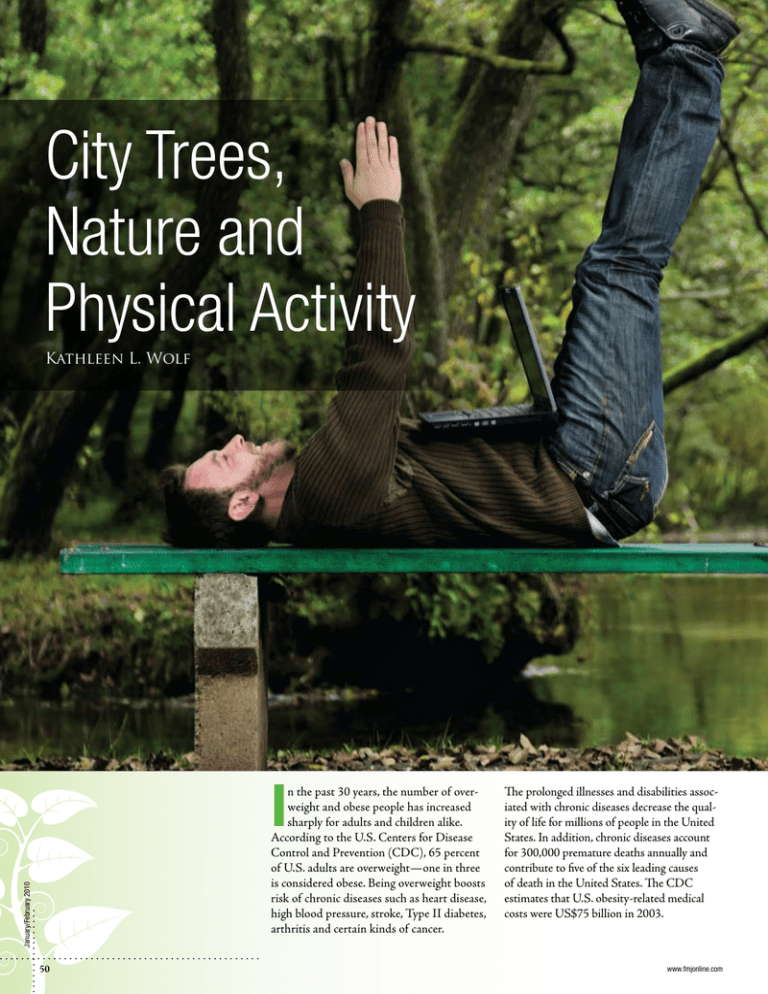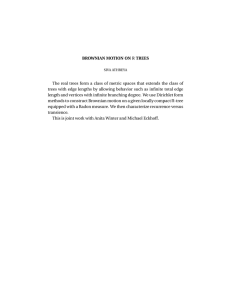City Trees, Nature and Physical Activity I
advertisement

City Trees, Nature and Physical Activity Kathleen L. Wolf I ................ January/February 2010 n the past 30 years, the number of overweight and obese people has increased sharply for adults and children alike. According to the U.S. Centers for Disease Control and Prevention (CDC), 65 percent of U.S. adults are overweight—one in three is considered obese. Being overweight boosts risk of chronic diseases such as heart disease, high blood pressure, stroke, Type II diabetes, arthritis and certain kinds of cancer. The prolonged illnesses and disabilities associated with chronic diseases decrease the quality of life for millions of people in the United States. In addition, chronic diseases account for 300,000 premature deaths annually and contribute to five of the six leading causes of death in the United States. The CDC estimates that U.S. obesity-related medical costs were US$75 billion in 2003. ................................................. 50 www.fmjonline.com ............................................... cite: Wolf, K.L. 2010 (January/February). City Trees, Nature and Physical Activity. Facility Management Journal 20, 1: 50-54. Earlier studies to explain low levels of physical activity emphasized demographic and household choice factors, but recent research shows that the built environment influences behaviors. Certain elements within the outdoor environment generally encourage good choices. Table 1 lists the urban conditions that support greater activity. Table 1: Determinants of city walkability Physical environment Higher population density (city core rather than suburbs) Higher housing density Mix of land uses (such as residential and retail) Street design with more connectivity (rather than cul-de-sacs) Facility Management Journal The solution Much of the chronic disease burden is preventable. Regular physical activity and healthy eating are essential. Physical activity need not be strenuous to be beneficial. Adults benefit from moderately intense physical activity, such as 30 minutes of brisk walking most days of the week. Yet more than 50 percent of U.S. adults do not get enough physical activity to provide health benefits; and 24 percent are not active at all in their leisure time. Activity decreases with age, and sufficient activity is less common among women than men and among those with lower incomes and less education. Walking and biking infrastructure (such as sidewalks and bike lanes) Psycho-social environment Safety from crime Safety from traffic Absence of social disorder Aesthetics (including trees and landscape) Educational campaigns Incentive programs (such as workplace reimbursement for transit use) Availability of public transit Trees and nature are an important element of outdoor environments that support activity. Research shows positive relationships between natural environments and psychological or social benefits. Activity settings Interest in strategies to promote physical activity has grown steadily. The CDC has launched multiple programs to create places that can benefit populations of people rather than focusing on changing physical activity behavior one person at a time. ................ January/February 2010 ................................................ www.fmjonline.com 51 Facility Management Journal ............................................... The rapidly growing research base includes studies about city trees and nature. Some ask about how the presence of parks and nature enable walking. That is, are there adequate physical spaces within a community where activity can occur? Other studies explore a more subtle question: Given that activity spaces are available, what is the role of trees and nature in motivating people to be active? Neighborhoods A Netherlands study showed that residents of neighborhoods with abundant green space generally enjoy better general health. This positive link was found to be most apparent among the elderly, housewives and people from lower socioeconomic groups. The character of neighborhoods also exerts significant effects on residents’ physical activity; thus, neighborhood design is becoming a public health issue. Once sidewalks and trails are in place, the presence of nature influences perception of and motivation for activity. In a study of European urban adults, residents of areas with the highest levels of greenery were three times as likely to be physically active and 40 percent less likely to be overweight or obese than those living in the least green settings. Also, people make more walking trips to task destinations (such as stores or coffee shops) when they perceive that there are many natural features in their neighborhood, including street trees. In less green neighborhoods people judge distances to be greater than they actually are—perhaps leading to decisions not to walk. ................ January/February 2010 Parks/public open space Table 2 shows a list of elements associated with park use. Not surprisingly, the evidence to date suggests that parks and open space support physical activity, particularly if there is easy access. One study found that people who use public open spaces are three times more likely to achieve recommended levels of physical activity than those who do not use the spaces. Users and potential users prefer nearby, attractive, and larger parks and open spaces. To date, few studies have tested for user response associated with varied vegetation character and management in parks, so the specific role of tree canopy is uncertain. Table 2: Determinants of park use Physical environment Quantity and quality of space Passive recreation amenities (such as walking paths or picnic areas) Absence of physical barriers (such as a major road between the park and home) Distance to park Access to competing local facilities (such as recreation centers) Level of park maintenance Psycho-social environment Characteristics of potential users (age, gender, ethnicity, socioeconomic status) Match between park attributes and perceived needs Perceived barriers Safety from crime Aesthetic features (presence of trees, water, birdlife) ................................................. 52 www.fmjonline.com Trails Trails can be found everywhere, from national and state parks to urban areas. In 2005, the Rails-to-Trails Conservancy counted 12,000 miles of trails. Future studies can help identify the features most likely to encourage active use by cyclists and pedestrians. Nonetheless, in one study, people showing stress response, measured as elevated blood pressure, were asked to take a long walk. Those who walked in a nature preserve showed a decline in blood pressure, while it increased for those walking in the urban environment. Also, subjects walking in the nature preserve showed increases in positive emotions, while those in the urban environment showed reduced levels. Community stewardship Largely overlooked in research to date is the role of tree stewardship programs and health. Volunteer stewards of all ages who routinely tend trees or work on urban forestry projects are probably gaining health benefits. One way to measure physical exertion is the metabolic ratio of an activity compared to rest conditions. Walking is a recommended moderate activity (a 3.5 exertion ratio). Stewardship activities produce exertion ratios ranging from 2.5 for mowing a lawn, to 4.5 for planting trees or shrubs (or pruning or weeding), to 5.0 for digging in soil, to 6.0 for gardening with heavy tools or using a chain saw. Health benefits are possible when citizens help steward nearby parks, trails and street trees. It’s all in the mind Studies show that the motivation to pursue nature and physical activity is complex. People in cities often feel stressed. If a person feels a need for a restorative experience, then he or she is more likely to prefer a natural environment to take a walk, rather than a built environment. are inclined to be more active, and claim the ability to relax faster. Why does the presence of nature motivate people to be more active? The “biophilia hypothesis” claims that humans have an innate attraction to the outdoor environment due to our evolutionary background. Many studies indicate the widespread aesthetic preferences that people have for trees, water and other natural elements. More directly, green areas in one’s living environment may ameliorate air pollution and urban heat island effects— creating more comfortable activity settings. Partnership and policy Promoting public health has long been a guiding tenet of urban forestry and landscape design. It is surprising that, until recently, this tenet has been largely overlooked in public discussion of strategies for combating obesity. Society is relearning the importance of urban nature. It provides the impetus to be utdoors and move about. Further research is needed to clearly identify specific natural features and areas that will encourage people to engage in physical activity, and to address the needs of diverse populations. City trees and green space are more than just a luxury and should be given more attention in urban planning and public health policies. A recent rash of studies confirms the essential role that trees and nature play. As organizations and elected leaders address the public costs of sedentary lifestyles, arborists and urban foresters are in a unique position to partner and provide high value for public health investments. FMJ “City Trees, Nature and Physical Activity” is a reprint from the February 2008 issue of Arborist News, published by the International Society of Arboriculture. If a person feels a need for a restorative experience, then he or she is more likely to prefer a natural environment to take a walk, rather than a built environment. People in large cities perceive themselves to be generally healthier if a greater percentage of the living environment is green space, Kathleen L. Wolf is a research social scientist at the University of Washington, Seattle. Her work focuses on the human dimensions of urban forests and ecosystems. Information about Wolf’s research program can be found at www.cfr.washington.edu. www.fmjonline.com






